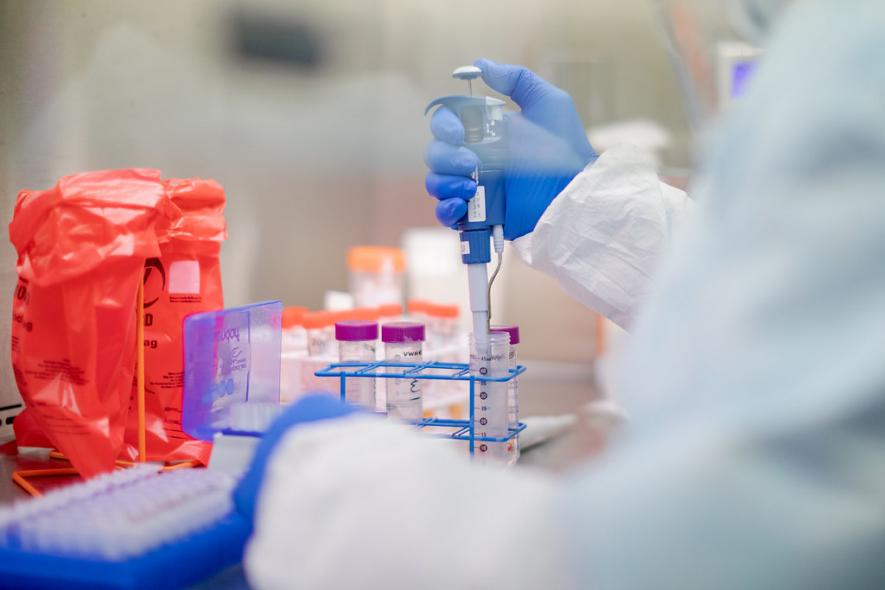Covid-19: When Polemics Substitutes for Science

Professor Beda M Stadler (former director of the Institute for Immunology at the University of Bern) in his blog on Medium argues: “The coronavirus is slowly retreating...The experts have missed basic connections. The immune response against the virus is much stronger than we thought.” He also argues against lockdowns, masks, and seemingly advocates a policy of doing nothing and the pandemic will simply fade away. He even writes that SARS-CoV-2 is disappearing globally. For a piece written on July 2, 2020, to say 'the virus retreating’ and ‘is gone for now' as he writes, would be funny if it was not so tragically wrong.
Sadly, Stadler’s points, some which are reasonable, when converted into polemic, lose whatever accuracy they have to begin with. In the process, he sets up straw men, knocks them down, and jumps to conclusions not warranted by either data or arguments.
Let us take some of his arguments.
Stadler claims, “Sars-Cov-2 isn’t all that new, but merely a seasonal cold virus that mutated and disappears in summer, as all cold viri do—which is what we’re observing globally right now.”
Contrary to his claim, nobody is pretending that SARS-CoV-2 is a ‘new virus’ throughout its sequence! But that does not mean, as he implies, that all 'cold viruses' are coronaviruses (coronaviri) and all cold viruses, will 'mutate and disappear in summer'; no, they do not all disappear in summer, nor do they do so by mutating.
Stadler claims that people have propagated “The fairy tale of no immunity…that this virus was particularly dangerous, because there was no immunity against it, because it was a novel virus.” His entire sentence is a concocted straw man target; nobody has said or is saying this. The actual likelihood 'everyone'—well, most of the field—has been discussing is that there does not seem to be any pre-existing effective protective immunity against SARS-CoV-2.
In the absence of prior exposure to SARS-CoV-2 itself, such immunity would come from exposure to other related 'coronaviri'. That does not seem to be the case, and therefore, we do not have any additional immunity developed from prior exposure. So most of us are likely to be infected when exposed to SARS-CoV-2 (and then develop anti-SARS-CoV-2 immunity). Therefore, the rate of transmission of the virus is quite high, helping it to spread rapidly in outbreaks. Even a small fraction of cases of serious illnesses could then overwhelm hospital facilities. The virus is, therefore, dangerous to communities, though not so much to individuals.
Further, Stadler's claim, 'Flu viri mutate significantly more, by the way, and nobody would ever claim that a new flu virus strain was completely novel' is actually incorrect in the context of practical immunisation policies. For example, we do in fact try to find/predict what new 'strain' of the flu virus is likely to be prominent in each coming season, and build new vaccine batches tailored to that strain.
Is there some degree of cross-protection between SARS-CoV-1 and SARS-CoV-2, as Stadler claims? Yes. But SARS-CoV-1 has not been particularly widespread, (thankfully, since its fatality rate is much higher!) so that immunity due to SARS-CoV-1 exposure is of no great significance in explaining the rate of global spread of SARS-CoV-2.
His implied claim that non-SARS beta-coronaviruses (such as the 'cold viri' he keeps taking about) provide cross-reactive immunity against SARS-CoV-2, is unsupported by evidence despite people looking for it. Is there absolutely no such cross-reactivity? Of course there is. But the evidence (from the un-reviewed Thiel and Drosten work Stadler cites, and from Alessandro Sette's paper in Cell, for example) says that this cross-recognition is quite modest. The key point here is that there is no evidence that this modest degree of cross-recognition provides any cross-protection. And that is why SARS-CoV-2 seems to be a new virus for humans in terms of immune protection.
The claim that seroprevalence (which indicates exposure to SARS-CoV-2) against SARS-CoV-2 is much greater than previously thought (which is what is implied in Stadler's Ioannidis story) is similarly more uncertain than he would like it to be.
It is true that the preliminary data from Los Angeles county (the Stanford study from Jay Bhattacharya that Stadler refers to as the study by John P A Ioannidis as a co-author) in an unreviewed publication, suggests that there may be a fairly large-scale community exposure to SARS-CoV-2, presumably as asymptomatic infections. This is what Indian Council of Medical Research’s (ICMR) unreviewed seroprevalence data from April 2020 also seems to suggest. A number of technical problems—at the mathematical level and possible selection bias—have been raised about the large number of perceived positives in the Stanford study. And of course, nobody appears to have actually seen the ICMR data.
Leaving these issues out, two points ought to be noted. First, neither report indicated or suggested that the seroprevalence was due to non-SARS-CoV-2 virus exposure, the context within which Stadler refers to them.
Second, more seroprevalence studies are now coming out --one from Geneva canton in Stadler’s Switzerland, another from Spain (both reviewed and published) -- which show much lower levels of seroprevalence than we would have expected from the Stanford study that Stadler quotes.
Data are uncertain and emerge slowly. But they now begin to indicate that the infection fatality rate of SARS-CoV-2 may likely be ~0.5%, significantly higher than seasonal flu or common cold viruses. This is NOT just a simple flu or a cold virus, though it is mercifully nothing like SARS-CoV-1 or MERS-CoV-1. That is why the position that the virus is dangerous to communities, though not so much to individuals, remains currently well supported by available evidence.
Stadler points to the failure of the most pessimistic epidemiological models to come true (so far!) because, he suggests, epidemiologists do not understand existing immunity in the population, and because 'coronaviri were seasonal cold viri that would disappear in summer'. Neither is true; it is simply because epidemiological models are not great.
And Stadler's remark that 'I have also not yet understood why epidemiologists were so much more interested in the number of deaths, rather than in the numbers that could be saved' is, sadly, a piece of gratuitous insult that no epidemiologist deserves, in fact, no researcher deserves.
Stadler says that Koch’s (Daniel Koch, former head of the Swiss Federal Public Health Office of Communicable Diseases) claim that children are not a driving factor in the epidemic is correct. Stadler also claims, 'almost no children under ten years old got sick, everyone should have made the argument that children clearly have to be immune'.
There is a major misunderstanding here between being asymptomatic and not being a driving factor. In any infection, if a fairly large number of all infected individuals (not just juvenile ones) are asymptomatic, yet shed fair amounts of virus for a few days, they are a potential source of transmission. Therefore, such people, including children will transmit the infection to others, some of who are more at-risk people due to co-morbidities. Children have far fewer co-morbidities (thankfully). Affliction by 'disease' (symptoms and signs) and an 'infection' (not necessarily accompanied by substantial symptoms and signs) are related but distinct matters, and cannot simply be equated with each other.
Stadler, of course, will have none of these nuances. In fact, he says:
'But this common sense seems to have eluded many, let’s call them “immunity deniers” just for fun. This new breed of deniers had to observe that the majority of people who tested positive for this virus, i.e., the virus was present in their throats, did not get sick. The term “silent carriers” was conjured out of a hat and it was claimed that one could be sick without having symptoms.'
I am sorry, but he has now lost me completely, since there are already multiple examples in medical textbooks of silent carriers of infectious microbes. There is even a Wikipedia page for 'asymptomatic carriers'! Remember typhoid Mary?
Stadler’s criticism of the qRT-PCR tests for SARS-CoV-2 similarly goes from the reasonable to the inaccurate. He is quite right that these tests do not distinguish between 'live' infectious virus and viral debris. But he then goes on to equate most, if not all test positivity with viral debris. The trouble with his understanding is that if virus particles are damaged (and rendered non-infectious), they degrade quite rapidly because they cannot repair themselves. So the correlation between detecting viral RNA and infectious virus, while not perfect, is quite strong. This is especially true since the qRT-PCR-detected SARS-CoV-2 viral RNA levels are non-trivial in most so-called 'positive' samples.
Stadler claims, 'But also people with a bad diet or who are malnourished may have a weakened immune system, which is why this virus does not only reveal the medical problems of a country, but also social issues.' This is an inappropriate oversimplification. Actual evidence does not support arguments of a generally 'weakened immune system' on any wide scale. Even mild protein-calorie under-nutrition does not hugely diminish immune responses.
Stadler's claim that inadequate levels of antibodies lead to T cell-mediated cytokine storms is also unsupported by both the general understanding of the mechanisms involved and by COVID-19-specific evidence. In fact, anti-SARS-CoV-2 antibody levels are higher in patients with severe illness than in people with mild symptoms.
His implication that plasma therapy works particularly well for children with the SARS-CoV-2-Kawasaki syndrome is also not what the data say. In fact, plasma therapy is still under evaluation for all severe COVID-19 illness, and while it has shown some utility in some studies, has not shown any dramatic cures (this is not surprising, but explaining that will take us far away from Stadler).
And when Stadler says, 'Those young and healthy people who currently walk around with a mask on their faces would be better off wearing a helmet instead, because the risk of something falling on their head is greater than that of getting a serious case of Covid-19', he shows yet another profound misunderstanding. The primary point of physical distancing (actual distancing, masks, hand-washing) in the SARS-CoV-2 pandemic, is a social responsibility to slow down transmission, not an individual act of fear for oneself alone. We protect each other, and that is how we protect ourselves together. That is why it is NOT just like wearing a helmet. It is, in fact, a component of what Stadler himself recommends as a strategy of protecting the at-risk people (people with co-morbidities, although he simply identifies them as the elderly).
Stadler also says:
'On our way back to normal, it would be good for us citizens if a few scaremongers apologised. Such as doctors who wanted a triage of over 80 year old Covid patients in order to stop ventilating them. Also media that kept showing alarmist videos of Italian hospitals to illustrate a situation that as such didn’t exist. All politicians calling for “testing, testing, testing” without even knowing what the test actually measures. And the federal government for an app they’ll never get to work and will warn me if someone near me is positive, even if they’re not infectious.'
What exactly is the point being made here? This is an unconnected set of alleged villains. In the first place, one would have expected his 'scaremongers' to be those who claimed 'new virus' and 'no immunity' and so on. But no, not at all; none of the above falls in that category!
The physicians and journalists in Italy and Spain, who pointed out that hospital facilities were getting overwhelmed with case numbers increasing very rapidly, were reporting facts on the ground, not describing situations that 'didn't exist'. They are not related to politicians, who one gathers are being castigated for being under-informed yet cautious, and calling for measures (such as apps) that may not work.
Yet, Stadler is quite right, that repeated 'lockdowns' are inappropriate. But that is because lockdowns are a desperate strategy saying we have failed, both as societies and as governments, to come up with sustainable responses for slowing down the spread of SARS-CoV-2 in our communities while caring, with social solidarity, for the underprivileged and the vulnerable, both the infected and the uninfected.
Sadly, Stadler's solution of doing almost nothing is no solution at all, as Brazil’s numbers are showing.
The writer was formerly with National Institute of Immunology, New Delhi, as well as with Translational Health Science And Technology Institute, Faridabad. The views are personal.
Get the latest reports & analysis with people's perspective on Protests, movements & deep analytical videos, discussions of the current affairs in your Telegram app. Subscribe to NewsClick's Telegram channel & get Real-Time updates on stories, as they get published on our website.
























